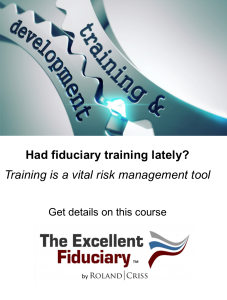Article
Fiduciary Duty is a Multi-Cultural Concept
“Stewardship” is originally a Phoenician term and the root word for “trust.” Stewards oversee, properly manage, and protect other peoples’ assets. “Trust” became the root word for “fiduciary,” used today to represent something “held or founded in trust or confidence.” Human resources leaders occupy a critical stewardship role; their maturity in that position is vital to millions of participants and their beneficiaries in 401(k), 403(b), and health and welfare plans.
Legal Compliance and Moral Virtues Underscore Stewardship
Human resources leaders are legal fiduciaries to their organizations’ employees. Stewardship and trustworthiness emerge not just as theoretical guiding principles but are embedded, essential ingredients in executive responsibility.
The focus on stewardship today does not insinuate executives’ ignorance of stewardship until now. Leaders have always intended to perform well and create value for their employees and enterprises. They have been stewards all along, but the intentional focus on prudent stewardship – to retain employees, enrich their lives with retirement and health programs, avoid risk and penalty, and grow as an organization – is primarily a recent phenomenon.
Integrating best practices into the operation of human resources programs is the line of demarcation between the “old era” and the “new era” of excellence. In the new era, the promise of intentional stewardship is mandatory for an employer’s success. And with a new success metric comes a demand for stewardship maturity that will drive and support those practices.
The Quest for Excellence
 The pursuit of excellence is just that: a quest. Suppose we believe that, in business, there are always areas to improve, change, and grow. In that case, excellence is not achieving a particular objective but instead perfecting the process used to achieve a goal.
The pursuit of excellence is just that: a quest. Suppose we believe that, in business, there are always areas to improve, change, and grow. In that case, excellence is not achieving a particular objective but instead perfecting the process used to achieve a goal.
In order to pursue excellence, there must be a developmental mindset rather than a complacent or stagnant one. With a commitment to developing people, systems, and best practices – and continuing to test those systems of performance – we work towards excellence with a stewardship mindset. The pursuit of stewardship, and excellence, is a constantly evolving journey.
Managing human resources and the programs that underscore their existing purposes includes establishing internal data security controls, devising standards for selecting and monitoring external service providers, and implementing consequences if performance falls below those standards. The management of human resources also consists of a responsibility to effectively manage the effect of regulations on such issues as cybersecurity, service providers’ fees, and the management of an investment decision-making process in the case of retirement and pension plans.
The imperative to act prudently, an often-used fiduciary term, reminds us that resources belong to someone else – and we must act on the conviction that our skills, controls, and performance all significantly affect the present circumstances and future financial status of others. Financial prudence, at its core, is acting in trust of someone else’s resources – whether it is an employee’s career, their retirement, or the culture in which they work. Financial prudence also suggests that there should be skill pursued and maturity developed that is relevant to the protection of those interests.
Linking Principles to Practices
 Admittedly, fiduciary principles found in laws like the Employee Retirement Income Security Act (“ERISA”), the Uniform Prudent Management of Institutional Funds Act (“UPMIFA”), and the Consolidated Appropropriation Act (“CAA”) lack a definition of the steps needed to meet the prudence principle they espouse. In response, the mature human resources organization will develop and observe practices that fulfill the fiduciary mandate expressed in statutes such as those mentioned.
Admittedly, fiduciary principles found in laws like the Employee Retirement Income Security Act (“ERISA”), the Uniform Prudent Management of Institutional Funds Act (“UPMIFA”), and the Consolidated Appropropriation Act (“CAA”) lack a definition of the steps needed to meet the prudence principle they espouse. In response, the mature human resources organization will develop and observe practices that fulfill the fiduciary mandate expressed in statutes such as those mentioned.
For leaders challenged by the call for maturity in human resources management, start with these three recommended steps to integrate operations with stewardship values, to “walk the talk,” and propel the mission.
Strategic planning is a critical component of every business culture. However, too often, the day-to-day processes, policies, and structures that govern human resources are left out of this strategic thinking. Effective organizations ensure that conversations about practice are part of the staff and C-level meetings and that strategic plans reference equitable, effective, and efficient methods that strengthen stewardship-centric operations.
Recognize that stewardship excellence is integral to realizing your organization’s values and strategy.
Human resources executives, critical players in corporate decision-making, can advocate for practices that embody values like loyalty, independence, and best interest. Stewardship maturity enables human resources organizations to do the hard work of examining principles and aligning them with enterprise values.
Provide human resources staff with training that will aid them in fiduciary tactics.
Stewardship behaviors don’t just happen. In order to mature, human resources leaders need to be clear about the stewardship disciplines, make a compelling case for their adoption, navigate organizational culture, rework entrenched processes, communicate with support staff, and implement new strategies.
Lead the Way
Being mindful of the stewardship disciplines elevates an enterprise’s orientation from a singular profit perspective to a holistic, process-centric vision, which, over time, produces the most rewarding results – through ethical, responsible, and intentional human resources practices.




